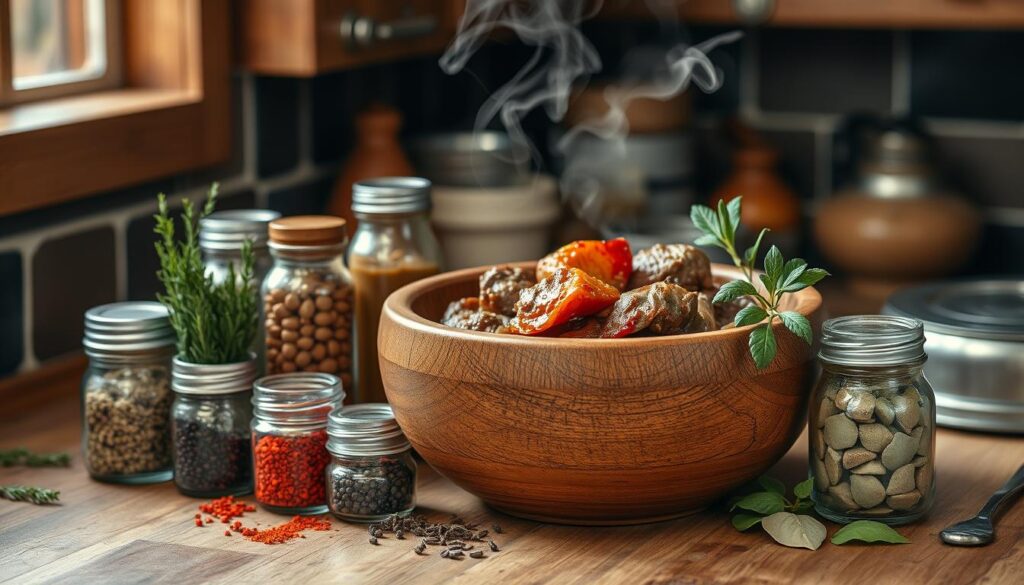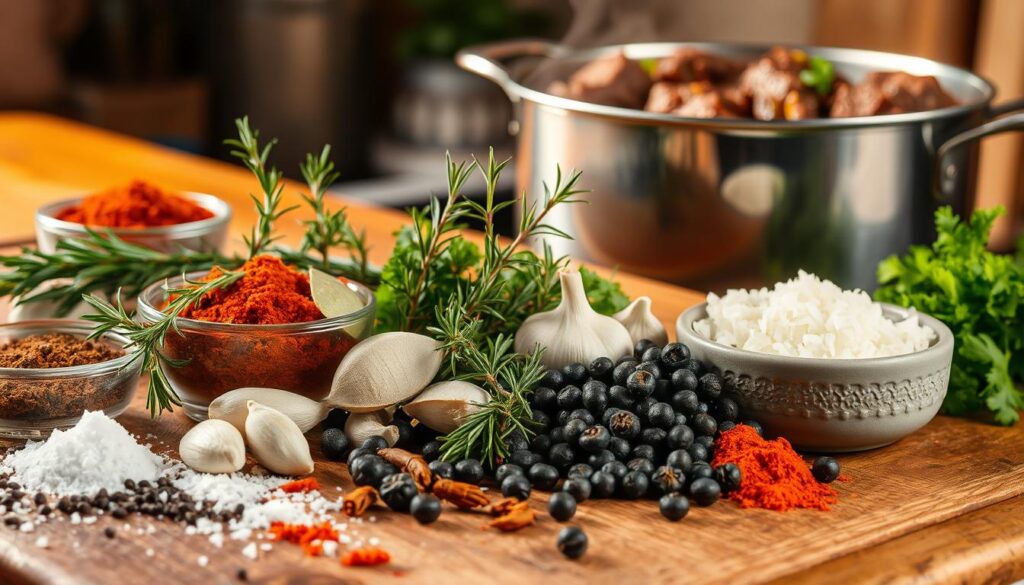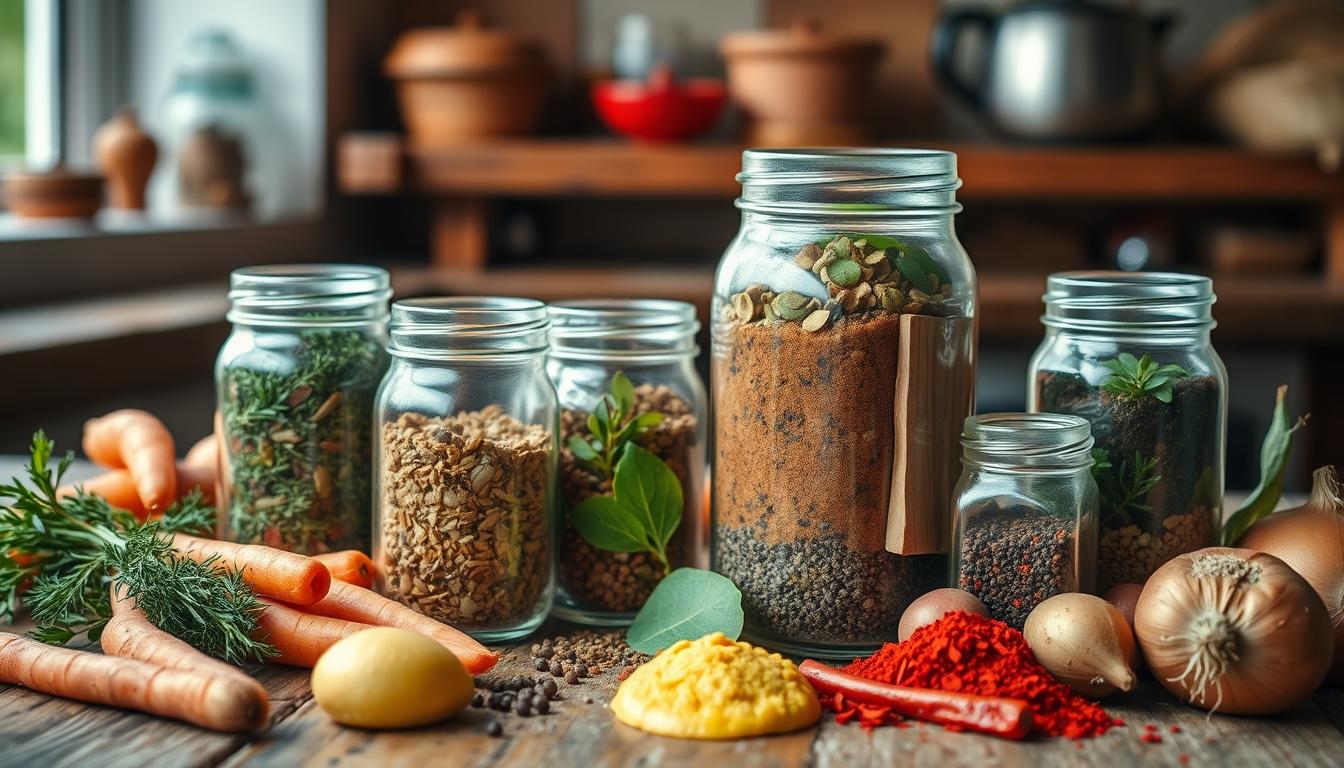You can make your own beef stew seasoning with natural ingredients. This lets you control the flavors and how much sodium is in it. Beef stew is a comforting dish that’s easy to make and affordable. With your own seasoning, you can make your stew taste even better.
Choosing the right beef stew seasoning is key to a flavorful stew. You can use paprika, chili peppers, and herbs like rosemary and thyme. These add depth and make the stew hearty and satisfying. Making your own seasoning lets you control the sodium and other ingredients.
Beef stew is a beloved comfort food. It’s made with beef, veggies, and a rich broth. The secret to a great stew is a top-notch seasoning. With homemade seasoning, you can make your stew taste amazing and tailored to your liking.
Key Takeaways
- Using a high-quality beef stew seasoning is key to a flavorful stew.
- A homemade seasoning mix lets you control flavors and sodium.
- You can customize your seasoning to create a unique taste.
- Good seasoning makes a big difference in your stew’s flavor.
- Homemade seasoning lets you manage sodium and other ingredients.
- Beef stew is a comforting dish made with beef, veggies, and broth.
- Homemade seasoning can make your stew delicious and satisfying.
What is Beef Stew Seasoning?
Beef stew seasoning is a mix of herbs and spices that makes beef stew taste better. It usually has onion powder, garlic powder, paprika, and thyme. These ingredients blend to give a rich, savory taste that goes well with the beef and other stew ingredients.
Getting the flavors right is key in beef stew seasoning. A good mix should have salty, sweet, and savory notes. You can make your own seasoning at home. For example, try mixing 2 tablespoons of onion powder, 2 tablespoons of paprika, and 1 tablespoon of dried thyme.

Using beef stew seasoning can really boost the flavor of your dish. A quality seasoning mix can turn a simple beef stew into a delicious treat. It’s perfect for both traditional recipes and new ones, making a big difference in taste.
Key Ingredients for Flavor
Onion powder, garlic powder, and paprika are key for flavor in beef stew seasoning. They add a deep flavor and aroma that’s hard to beat. Thyme and rosemary also add a savory, slightly bitter taste that balances the sweetness of the beef and other ingredients.
How It Enhances the Dish
Beef stew seasoning adds a rich, complex flavor to the dish. The mix of herbs and spices creates a flavor that’s more than just the sum of its parts. With a high-quality seasoning mix, your beef stew will be full of flavor and aroma, pleasing even the most critical eaters.
Benefits of Using Seasoning in Beef Stew
Adding a flavorful beef stew seasoning can take your dish to the next level. The right mix of spices creates a rich, savory taste that goes well with tender beef and fresh veggies. Choosing a natural seasoning lets you manage the salt and other ingredients in your stew.
Homemade beef stew seasoning is a time-saver. It lets you quickly add flavor to your stew without measuring out each spice. This is great for busy cooks who want a tasty meal without spending hours cooking.
Improves Flavor Profile
A good seasoning mix balances savory, sweet, and spicy flavors. Ingredients like paprika, garlic powder, and dried herbs are key. Fresh and dried herbs add depth to the stew’s flavor, allowing you to experiment with different tastes.
Saves Time in Preparation
Using a pre-mixed seasoning saves kitchen time. With a flavorful blend, you just add it to your stew and let it simmer. This makes it easy to make a delicious stew, even on a tight schedule.
Brands like McCormick’s and Penzeys Spices offer pre-made seasoning blends. But you can also make your own with natural ingredients like flour, onion powder, and herbs. Making your own seasoning lets you control the sodium and ingredients, making your stew healthier for you and your family.
Classic Beef Stew Seasoning Recipe
To make a tasty beef stew, you need the right mix of herbs and spices. A classic recipe includes onion powder, paprika, and cayenne pepper for a bit of heat. For a spicy version, add more cayenne pepper. For a traditional taste, use less or no cayenne pepper.
Choosing the right seasoning depends on the beef type. Boneless beef chuck with marbling is best for a tender stew. You can also add balsamic vinegar, tomato paste, and dry red wine for extra flavor.
Ingredients You’ll Need
- 2 tablespoons of onion powder
- 1 tablespoon of paprika
- 1 teaspoon of cayenne pepper (optional)
- 1 teaspoon of salt
- 1/2 teaspoon of black pepper
Step-by-Step Instructions
To make the seasoning, mix all the ingredients in a bowl. Store it in an airtight container for up to 6 months. Rub the seasoning on the beef before cooking and add it to the stew pot.

Follow this classic recipe to make a delicious beef stew. It’s great for any occasion, whether you like it spicy or traditional.
Tips for Choosing the Right Seasoning
Choosing a beef stew seasoning blend can be tough. Think about the herbs and spices in the mix. Fresh herbs like thyme and rosemary bring a bright taste. Dried herbs offer a milder flavor. Experts say the right seasoning can really enhance your stew’s taste.
A top-notch seasoning mix should have a mix of savory spices and herbs. Look for one with garlic, onion, paprika, and black pepper for extra flavor. Some brands offer seasoning blends without additives, perfect for a natural taste.

Fresh vs. Dried Herbs
Fresh herbs add a lively flavor but can be pricey and short-lived. Dried herbs are easier to store and last longer. Mixing both fresh and dried herbs can create a unique and tasty flavor.
Brand Recommendations
Some brands are known for their great beef stew seasoning mixes. Choose brands known for quality and taste. The right seasoning can turn your stew into a hearty, satisfying meal.
How to Use Beef Stew Seasoning
Using homemade beef stew seasoning can make your dish taste better. It lets you customize the flavor. Knowing when to add the seasoning and how to adjust it is key.
When to Add Seasoning
The best time to add seasoning is during the browning process. This lets the flavors mix well and get stronger. Adding it towards the end can make the flavor less intense.
Adjusting for Taste Preferences
To adjust the seasoning, start with a small amount. Then, taste and adjust as needed. You can also change the seasoning blend to fit your taste. For example, add more onion powder if you like a stronger onion flavor.
A good beef stew seasoning recipe includes flour, onion powder, black pepper, paprika, and dried herbs. You can adjust the amounts to your liking. Here’s a sample nutritional breakdown for a homemade beef stew seasoning recipe:
| Nutrient | Amount per Tablespoon |
|---|---|
| Calories | 19 |
| Sodium | 437mg |
| Potassium | 29mg |
| Fiber | 1g |
| Protein | 1g |
| Sugar | 0.1g |

By following these tips and using homemade seasoning, you can make a delicious beef stew. Remember to keep your seasoning blend in an airtight container to keep its flavor and aroma.
Pairing Ingredients for Ideal Stew
To make a tasty beef stew, picking the right ingredients is key. The first source says the right mix can really boost the flavor. For beef stew seasoning ingredients, some work better than others. Carrots, celery, and potatoes are great, and thyme and bay leaves add a special taste.
Choosing the right beef stew seasoning ingredients depends on your broth. A low-sodium beef broth is a smart pick, letting you control the salt. Adding red wine can make it even more flavorful. To make your stew, brown the beef first. Then, add the aromatics and broth. Let it simmer until the beef is tender. After that, add your favorite veggies and herbs.
Here are some tips for pairing ingredients:
- Choose tender cuts of beef, like beef chuck, for a flavorful stew.
- Select a variety of colorful vegetables to add visual appeal and nutrients.
- Don’t forget to add fresh herbs, like parsley or thyme, for a bright, fresh flavor.
By following these tips and using the right beef stew seasoning ingredients and beef stew seasoning instructions, you’ll make a delicious beef stew.
| Ingredient | Quantity |
|---|---|
| Beef chuck | 2 lb |
| Onion | 1 |
| Carrots | 4 |
| Celery | 2 stalks |
Common Mistakes to Avoid
When making beef stew, knowing common mistakes is key. These mistakes can ruin the flavor and texture. By using beef stew seasoning tips, you can avoid over-seasoning. A big trick is to taste and adjust as you go, not all at once.
Some common mistakes to avoid include:
- Over-seasoning, which can overpower the other flavors in the stew
- Ignoring cooking times, which can result in tough or undercooked meat
- Not browning the meat properly, which can affect the texture and flavor of the stew
To avoid these mistakes, following beef stew seasoning tips is essential. Use high-quality ingredients for a delicious stew. Always taste and adjust as you go. Don’t be afraid to try new beef stew seasoning tricks to find the perfect flavor.
By avoiding these mistakes and following beef stew seasoning tips, you can make an amazing beef stew. So, get creative with your beef stew seasoning tricks. Enjoy making a delicious and satisfying meal.
| Mistake | Consequence | Solution |
|---|---|---|
| Over-seasoning | Unbalanced flavor | Taste and adjust as you go |
| Ignoring cooking times | Tough or undercooked meat | Follow recommended cooking times |
| Not browning the meat | Affected texture and flavor | Brown the meat properly before adding to the stew |
Storage Tips for Leftover Seasoning
To keep your beef stew seasoning fresh, proper storage is key. Ground spices can stay fresh for a year if stored right. Whole spices can last 3 to 5 years if stored correctly. Always store spices in airtight containers to keep their flavor and freshness.
For beef stew seasoning ideas, it’s not just about the spices. How you store leftover stew is also important. You can store beef stew in the fridge for 3-4 days or freeze it for up to 3 months. But, the potatoes and veggies might be softer when thawed.
To keep your stew quality high, label containers with the date and what’s inside. Store them in the freezer at 0°F (-18°C) or below.
- Store spices in a cool, dry place, away from direct sunlight and moisture.
- Use airtight containers to prevent air and moisture from entering.
- Label spices with their name and purchase date to monitor their freshness.
- Check spices regularly for any signs of spoilage, such as a dramatic change in color, smell, or taste.
By following these storage tips, you can enjoy your beef stew seasoning for longer. This way, you keep their flavor and freshness intact.
Creative Ways to Use Beef Stew Seasoning
Beef stew seasoning is not just for stew. It can make many dishes taste better. Try it on roasted potatoes for a savory kick or in ground beef for tasty meatballs. There are countless ways to use this blend of herbs and spices.
Beyond Traditional Stew
Don’t just use beef stew seasoning for stew. Mix it into ground beef for juicy burgers or rub it on roasts and briskets. It’s also great in slow-cooked chili, hearty soups, or braised short ribs.
Incorporating into Other Dishes
Beef stew seasoning adds flavor to more than just beef. Add it to mashed potatoes for extra taste or on roasted veggies like carrots and Brussels sprouts. Even try it on popcorn or in dips. The uses for this seasoning are endless.

